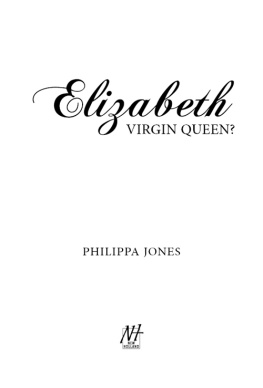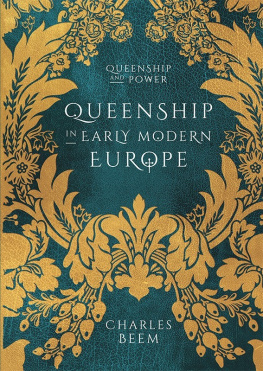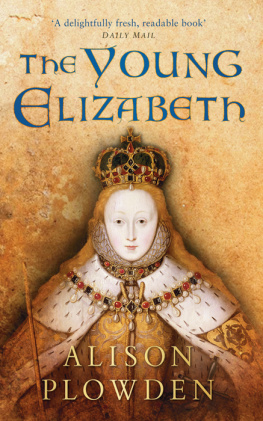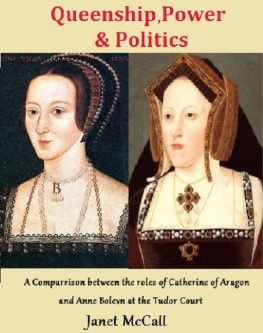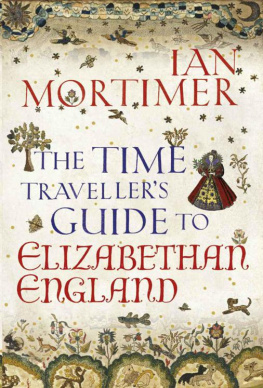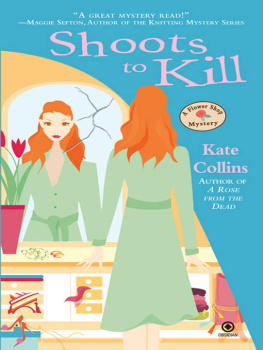Linda Collins - Gloriana: Elizabeth I and the Art of Queenship
Here you can read online Linda Collins - Gloriana: Elizabeth I and the Art of Queenship full text of the book (entire story) in english for free. Download pdf and epub, get meaning, cover and reviews about this ebook. year: 2022, publisher: The History Press, genre: Non-fiction. Description of the work, (preface) as well as reviews are available. Best literature library LitArk.com created for fans of good reading and offers a wide selection of genres:
Romance novel
Science fiction
Adventure
Detective
Science
History
Home and family
Prose
Art
Politics
Computer
Non-fiction
Religion
Business
Children
Humor
Choose a favorite category and find really read worthwhile books. Enjoy immersion in the world of imagination, feel the emotions of the characters or learn something new for yourself, make an fascinating discovery.
- Book:Gloriana: Elizabeth I and the Art of Queenship
- Author:
- Publisher:The History Press
- Genre:
- Year:2022
- Rating:4 / 5
- Favourites:Add to favourites
- Your mark:
- 80
- 1
- 2
- 3
- 4
- 5
Gloriana: Elizabeth I and the Art of Queenship: summary, description and annotation
We offer to read an annotation, description, summary or preface (depends on what the author of the book "Gloriana: Elizabeth I and the Art of Queenship" wrote himself). If you haven't found the necessary information about the book — write in the comments, we will try to find it.
Gloriana: Elizabeth I and the Art of Queenship — read online for free the complete book (whole text) full work
Below is the text of the book, divided by pages. System saving the place of the last page read, allows you to conveniently read the book "Gloriana: Elizabeth I and the Art of Queenship" online for free, without having to search again every time where you left off. Put a bookmark, and you can go to the page where you finished reading at any time.
Font size:
Interval:
Bookmark:



First published 2022
The History Press
97 St Georges Place, Cheltenham,
Gloucestershire, GL50 3QB
www.thehistorypress.co.uk
Siobhan Clarke & Linda Collins, 2022
The right of Siobhan Clarke & Linda Collins to be identified as the Authors of this work has been asserted in accordance with the Copyright, Designs and Patents Act 1988.
All rights reserved. No part of this book may be reprinted or reproduced or utilised in any form or by any electronic, mechanical or other means, now known or hereafter invented, including photocopying and recording, or in any information storage or retrieval system, without the permission in writing from the Publishers.
British Library Cataloguing in Publication Data.
A catalogue record for this book is available from the British Library.
ISBN 978 1 8039 9092 7
Typesetting and origination by The History Press
Printed and bound in Great Britain by TJ Books Limited, Padstow, Cornwall
eBook converted by Geethik Technologies

SOME ARE BORN GREAT, SOME ACHIEVE GREATNESS
WILLIAM SHAKESPEARE

Writers have portrayed the life and reign of Queen Elizabeth I for centuries in books, plays and films and the fascination remains today. Easily one of our most popular monarchs, in 2002 she was among the list of 10 Greatest Britons in a BBC poll. She is admired as a successful leader and a woman ahead of her time who is an integral part of Englands national story. But her early life was full of uncertainties and she was an unlikely candidate to be the greatest offspring of Henry VIII. This daughter, by Anne Boleyn, was the wrong sex in a world governed by men and she was often considered illegitimate because her parents marriage was annulled. The odds were stacked against her, but Elizabeth would survive the vicissitudes of her siblings reigns, numerous Catholic plots to kill her, the formidable Spanish Armada and the most obvious obstacle of all: her gender.
On becoming Queen, Elizabeth needed a very strong image to unite her country and consolidate her power. Art was a powerful device for displaying royal magnificence and for propaganda but a mere likeness would never be sufficient. Elizabeths portraits increasingly relied on glittering jewels, gowns and accessories for the projection of majesty. Along with her formidable grasp of public relations, her persona was a vital ingredient of her rule. The Cult of Gloriana developed towards the end of her reign, a movement in which authors, musicians and artists such as Spenser, Shakespeare, Tallis, Byrd and Hilliard revered her as a virgin goddess, unlike other women. It was an idea sustained by public spectacle, chivalry, sonnets and oration which paid homage to Elizabeth as a deity. The Queens image was widely owned and distributed for the masses, thanks to the expansion of printing and, for the wealthy, through the medium of the painted portrait.
Elizabeths England was a small kingdom on the fringes of Europe which grew in self-confidence, in no small part because of the Queen herself. Her long reign provided domestic peace and stability, allowing the arts to flourish so that the Elizabethan era would prove to be a Golden Age. The eighteenth-century antiquarian Horace Walpole said in his Anecdotes of Painting in England that there was no evidence that she had much taste for painting, but she loved pictures of herself. Successive periods in history have invested her reign with significance and a large part of this legacy is her captivating image.
The allegory referred to in this painting is the Judgement of Paris, a theme derived from Greek mythology which also became popular in Roman art. Three of the most beautiful goddesses, Venus, Juno and Minerva, compete for the prize of a golden apple, dedicated to the fairest. Jupiter, King of the Gods, was intended to judge the competition, but instead he nominated Paris, Prince of Troy, to carry out the task. Paris chose Venus as the winner on the strength of her promise to help him win the hand of the most beautiful woman alive, Helen, the wife of Menelaus, King of Sparta. (It was Pariss seduction of Helen and his refusal to return her that led to the Trojan Wars.)
The panel can be visually divided into two sections. To the left-hand side, Elizabeth is emerging as though onto a stage. She enters the scene through a classical archway leading from a substantial brick building. Inside the open door of the structure can be glimpsed a gold coffered ceiling, a frieze containing the Tudor coat of arms and a canopy displaying her own arms. She is wearing a crown and carrying an orb and sceptre, the most powerful attributes of monarchy. Her ladies-in-waiting are deep in conversation and are perhaps unable to see the vision before them. They are superfluous to the allegory, but they serve to ground the Queen in reality. Elizabeth would not have travelled anywhere without her accompanying ladies.
The right side of the picture is allegorical, with the three goddesses presenting a riot of movement and vivid colour. They are set into a pastoral landscape that includes a depiction of Windsor Castle and Venuss chariot drawn by swans.
As the painting was commissioned either by Elizabeth or as a gift to her, the Queen would have been expected to take centre place in the composition. However, she has been supplanted by Juno, the goddess of marriage and fertility. Juno, Queen of the Gods, is gesturing for Elizabeth to follow. The position of her arm is echoed by the curved neck of the crowned peacock, her sacred bird. But Elizabeth will not be enticed by Junos association with matrimony and family life.
In the middle of the three allegorical figures is Minerva, the goddess of battle strategy and wisdom, whose powers include bestowing heroes with courage. She wears a helmet and a breastplate embellished with the head of a gorgon, and she carries a standard. The gorgon, with its hair of venomous snakes, was given to Minerva by Perseus as protection. Anyone looking at a gorgon was turned immediately to stone. In common with Elizabeth, Minerva, the warrior maiden, was believed to remain perpetually a virgin.
On the far right is Venus, the goddess of love, beauty, pleasure and passion. Her discarded smock belongs to the age of Elizabeth rather than a world of myth. Its distinctive and colourful embroidery is typical of Tudor design of this time. The broken arrows on the ground, the bow and the discarded quiver refer to Venuss son Cupid, who tried in vain to shoot Elizabeth with his darts of love. The implication is that despite her beauty, Elizabeth is impervious to matters of the heart.
The goddesses reflect the choices Elizabeth has made to rule wisely. Juno represents Elizabeths rejection of marriage and children, Minerva emphasises her skill, wisdom and courage in battle and Venus alludes to the Queens beauty and the life of pleasure that she has rejected, enabling her to govern her nation wisely. And yet, it is Elizabeth who retains the prize not a golden apple but a golden orb, a powerful symbol of monarchy that represents the Queens triumph over all three of these classical goddesses.
Font size:
Interval:
Bookmark:
Similar books «Gloriana: Elizabeth I and the Art of Queenship»
Look at similar books to Gloriana: Elizabeth I and the Art of Queenship. We have selected literature similar in name and meaning in the hope of providing readers with more options to find new, interesting, not yet read works.
Discussion, reviews of the book Gloriana: Elizabeth I and the Art of Queenship and just readers' own opinions. Leave your comments, write what you think about the work, its meaning or the main characters. Specify what exactly you liked and what you didn't like, and why you think so.








